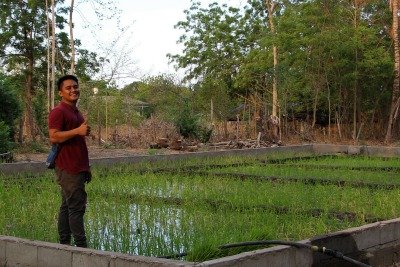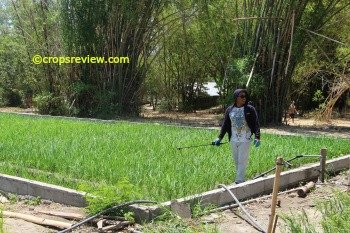No rice paddy or lowland rice field where the science and practice of rice production are taught? The land is unsuitable for lowland agriculture?
The remedy should be to build such a paddy out of concrete.
That exactly was what we did!
But only in limited area for instruction and research.

The structure is located at the Mindanao State University – Fatima Campus, General Santos City, Philippines.
Soil is sandy loam with shallow topsoil commonly only up to 30 cm deep and deeper it’s mostly sand.
Rainfall used to be very rare to the point that it became a joke in the 90’s that the climate was “dry” and “very dry”.
There was no irrigation from a natural source and until now there is none. Tree growth was then sparse.
The campus was likened to a desert though I was in favor of developing it as a venue for arid or semi-arid research.
But the university, through its College of Agriculture, offers a degree in agronomy.
Laboratory activities on rice production had to be conducted then in private farms outside of the campus.
There must be a way to grow lowland rice! I told myself even though I was not the one handling the course.
And so I tasked myself to find the solution.
Conceptualization of the Concrete Rice Paddy
I had read that the Hanging Gardens of Babylon:
- were probably made and supplied with irrigation water to simulate a mountain of the forest;
- that thousands of tropical plants including trees were grown in a huge dome-shaped enclosure called Climatron in the USA;
- that banana had been grown on the desert;
- and that greenhouses had been used to grow seedlings and ornamental plants.
I knew the use of plastic tents in stem cutting propagation as well as in making bonsai, and I had handled propagules and reared plantlets and seedlings indoor in tissue culture laboratories.
I’d seen those experimental rice plants grown in buckets, and I’d seen those raised sink-like structures made of galvanized plain sheets filled to near full with water.
Pots containing rice in various stages of growth were kept immersed.
All the above-involved manipulation of the environment to produce one desirable for plant growth.
Indeed, if the growth of any desired crop is a must but the land is unsuitable, there is no other way but to modify the land in order to produce a suitable environment.
Otherwise, introduce man-made structures, or apply engineering to provide necessary inputs.
So if a rice paddy even with a size intended only for demonstration is out of the question due to the limited water supply compounded by the high rate of downward and sideward movement of water, why not build a concrete enclosure complete with walls and floor?
So that’s it!

Plan to Build a Concrete Rice Paddy was Conceived
The proposed paddy field was to be in the form of a rectangular box with an open top.
It was to become a rice “box” or “kahon,” a subdivision of a lowland rice field bounded by levees.
For levees, the structure was to have concrete walls to prevent seepage and spillage of water.
The floor must also be made of concrete to prevent unhampered percolation, or downward movement of water, in the simulation of hard pan.
The crop area when finished should be about 20 m long and 10 m wide.
As to the deepness of soil when the filling subsided, I theorized that 50 cm from top to bottom should be sufficient.
My basis was that in plowing, the depth of penetration of the plow shear is only up to about 20 cm.
I made the proposal to then Dean Arturo Amparado in 1999 and right away he gave his approval.
He immediately facilitated the procurement of construction materials and the supply of manpower.
The plan was executed with haste.
Why 20 m x 10 m?
Planning also considered the potential use of the rice paddy for research or simple experiments following appropriate experimental designs.
With a width of 10 m, at least 3 blocks or replications could be accommodated.
Each block would be 20 m long from the eastern to the western wall which can be divided further into subplots arranged in a Randomized Complete Block design.
The measurements though may have to reckon the provision of canals.
